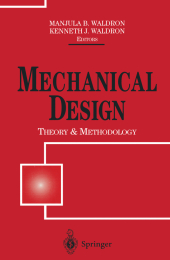 Neuerscheinungen 2012Stand: 2020-01-07 |
Schnellsuche
ISBN/Stichwort/Autor
|
Herderstraße 10
10625 Berlin
Tel.: 030 315 714 16
Fax 030 315 714 14
info@buchspektrum.de |

Kenneth J. Waldron, Manjula B. Waldron
(Beteiligte)
Mechanical Design: Theory and Methodology
Herausgegeben von Waldron, Manjula B.; Waldron, Kenneth J.
Softcover reprint of the original 1st ed. 1996. 2012. xii, 387 S. 53 SW-Abb., 22 Tabellen. 235 mm
Verlag/Jahr: SPRINGER, BERLIN; SPRINGER NEW YORK; SPRINGER 2012
ISBN: 1-475-72563-9 (1475725639)
Neue ISBN: 978-1-475-72563-6 (9781475725636)
Preis und Lieferzeit: Bitte klicken
This volume, Mechanical Design: Theory and Methodology, has been put together over the past four years. Most of the work is ongoing as can be ascertained easily from the text. One can argue that this is so for any text or monograph. Any such book is only a snapshot in time, giving information about the state of knowledge of the authors when the book was compiled. The chapters have been updated and are representative of the state of the art in the field of design theory and methodology. It is barely over a decade that design as an area of study was revived, mostly at the behest of industry, government, and academic leaders. Profes sor Nam Suh, then the head of the Engineering Directorate at the National Science Foundation, provided much of the impetus for the needed effort. The results of early work of researchers, many of whom have authored chapters in this book, were fundamental in conceiving the ideas behind Design for X or DFX and concurrent engineering issues. The artificial intelli gence community had a strong influence in developing the required com puter tools mainly because the field had a history of interdisciplinary work. Psychologists, computer scientists, and engineers worked together to under stand what support tools will improve the design process. While this influ ence continues today, there is an increased awareness that a much broader community needs to be involved.
1. Introduction.- 2. The Influence of the Designer´s Expertise on the Design Process.- 3. Methods of Studying Mechanical Design.- 4. Design Characterizations.- 5. An Observational Methodology for Studying Group Design Activity.- 6. Representation of Conceptual Mechanical Design Knowledge.- 7. Configuring Systems Using Available Assets: A Conceptual, Decision-Based Perspective.- 8. Group Decision Making in Design.- 9. Routineness Revisited.- 10. A Comparative Analysis of Techniques in Engineering Design.- 11. A Data Representation for Collaborative Mechanical Design.- 12. Characterizing Human Analogical Reasoning.- 13. Entropy Measures in Engineering Design.- 14. Design Education.- 15. Life-cycle Design.- 16. Support for Workflow Process Collaboration.- 17. Improved Total Development Process: Overcoming the Ten Cash Drains.
"Well presented and easy to read, this book should be on the bookshelf of every engineering designer and should be frequently read." Materials & Manufacture


